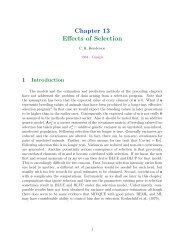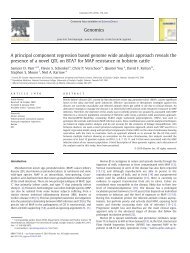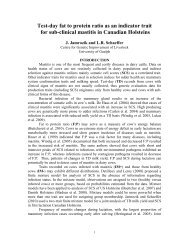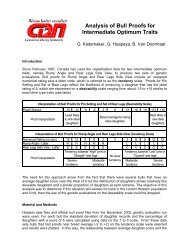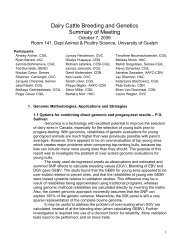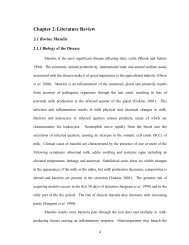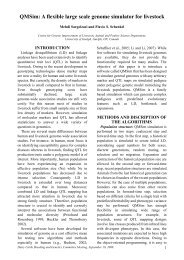September 2006 - CGIL
September 2006 - CGIL
September 2006 - CGIL
Create successful ePaper yourself
Turn your PDF publications into a flip-book with our unique Google optimized e-Paper software.
eported in other studies. In addition to the effects of pregnancy this drop in milk production was<br />
confounded by effect of DIM.<br />
It was noted that more than 35% of the cows were found to never become pregnant in first<br />
lactation, which was an expected result. However, 60% of the cows were recorded as not yet<br />
becoming pregnant when the test was taken. This percentage was expected to be closer to 30%.<br />
Cows coded as not becoming pregnant until after 310 days in milk had the highest level of milk<br />
production. Perhaps the owners of these cows chose not to inseminate these cows until later in<br />
lactation because they were high producers. A suggestion was made to graph the decline of milk<br />
production in terms of percentage of yield rather than by kilograms of yield so that the decrease<br />
can be compared across breeds. In addition, estimation of the interaction between stage of<br />
lactation and stage of pregnancy was recommended.<br />
2 CONFORMATION TRAITS, i. Genetic Evaluation (Domestic)<br />
2.1 Table showing if Fixed or Random contemporary group was included in analysis<br />
This table was given to the committee for reference, but was not discussed.<br />
2.2 Approximate Reliability Patch for Conformation<br />
Sullivan and VanDoormaal<br />
CDN started providing Parent Averages (PA) for animals whose index or proof could not be<br />
calculated. Due to some inconsistencies between reliabilities calculated in February and those<br />
calculated in May (specifically unexpected drops in reliabilities), a review of the reliability<br />
approximation procedure used in the new type system was initiated. Researchers found no errors<br />
in the methodology, but rather an issue with how the approximation was designed. Drops in<br />
reliability from one proof run to the next, although theoretically possible, could cause problems<br />
with extension. Therefore, it was decided to modify the procedure to ensure that the PA reliability<br />
never went down.<br />
The modification (or patch) substituted the matrix of Tier and Meyer with one that accounted for<br />
knowing sire and dam were mates in the parent contribution of the approximation algorithm. In<br />
this case, the parent contributions to reliability were corrected to be a maximum of 50% (rather<br />
than 40%).<br />
Changes in reliability between the old and new approximation procedures were summarized.<br />
Changes were small for animals with either low or high reliability. Animals with originally<br />
intermediate reliability (20-60%), which would be mostly based on parent information, changed<br />
by 2 to 3 percentage points. After the patch was applied, reliabilities only increased as desired.<br />
Changes in reliabilities between procedures were smaller if old reliabilities were high.<br />
Researchers concluded that extension problems related to decreases in parent average reliabilities<br />
would have mostly applied to animals that did not have contemporaries for their first official<br />
evaluation, since their own performance record would not contribute to the reliability. Small<br />
contemporaries are less common in production evaluations. Therefore, investigation into applying<br />
a similar patch to the reliability approximation procedure for production traits was not suggested.




